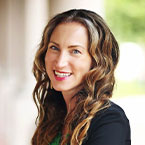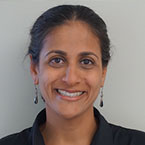By: Katie Durrwachter-Erno, MD, FAAP & Lisa Patel, MD, MESc, FAAP
Wildfires are a threat to homes and communities. They cause stress and harm to those in their path. If you don't live where wildfires are increasingly common, you may not think about how or why they relate to climate change. But the damage from more frequent wildfire smoke still can affect your child's health.
Web pages whose development was supported by federal government grants are being reviewed to comply with applicable Executive Orders.
Wildfire smoke can blow thousands of miles away. Previous fires on the West coast, for example, have caused poor
air quality days on the East coast. The health effects were felt by children and pregnant women across the country.
Here is the good news. We can take steps to address climate change and reduce wildfires. Our actions also will improve children's health and mental health. Let's explore the connection between wildfires and
climate change—and the impact on children now and in the future.
When is wildfire season?
In the United States,
wildfire season has become longer. This has quite a bit to do with the conditions that help fires start and stay burning. This, in turn, is connected to the effect of climate change on seasons and
weather patterns.
Climate change is causing extreme heat, more drought and less rainfall, as well as longer summers. All of these
raise the risk for wildfires. We are seeing:
What causes wildfires?
Humans are responsible for nearly
85% of wildfires. Causes include unattended campfires, burning debris, equipment fires, discarded cigarettes and arson. Human activities also create
greenhouse gas emissions and pollution—these play a major role in climate change, as well.
Cutting down on damaging human behaviors can prevent future harm to children from wildfires. For now, families and communities must take action to protect themselves, or adapt, to wildfire risks.
What are the health risks of wildfires for children?
Wildfires burn trees, plants, entire homes and buildings and everything inside them. The smoke from wildfires is more dangerous than
particle pollution from other sources (dust, dirt, soot, drops of liquid). It makes the
air quality worse far away from the fire, too. Wildfire smoke causes health problems because it releases:
tiny particles (smoke) in the air that can be inhaled, enter a child's bloodstream, and affect the heart and blood vessels, and
cancer-causing chemicals
Repeated exposure to
wildfire smoke affects a child's heart and lung health over their lifetime. Research links it to
preterm birth and low birth weight. Wildfire smoke exposure in early childhood may also be linked to chronic lung problems and immune system problems later in life.
Who is at most risk of health effects from wildfires?
All children are at risk of short-term physical health effects from a wildfire event.
They may have:
Chest tightness or pain
Burning sensation of the nose, throat and eyes
Breathing trouble, cough, wheezing or pneumonia
Dizziness, lightheadedness or headaches
Sometimes, children may have physical
symptoms linked to their mental health, such as stomachache or headache. Families should watch their children for signs of emotional distress.
Some children are at a higher risk of physical symptoms:
For example, these include:
Infants and young children. Their lungs are still developing. Young children also breathe in more air per minute for their body size and often are more active than adults.
Children with asthma and other lung diseases. They have a higher risk of breathing and other respiratory symptoms because they may experience new wheezing or worsening symptoms.
How can I keep my child safe from wildfire smoke?
Families who live in wildfire zones should have a
disaster plan in place to follow before, during and after wildfires. Here are some of the ways to
avoid exposure to poor air quality, smoke and ash due to wildfires.
Stay indoors as much as possible. Clean the air inside using a central system with a
MERV 13 filter or higher, or portable air purifier with a high-efficiency particulate air (HEPA) filter. If cost is prohibitive, a
"do-it-yourself" purifier can be made with a box fan and HEPA filter from the hardware store.
If you must travel outside, choose a mask or respirator that is fully protective for wildfire smoke events. Your child's age, ability to wear the mask, health conditions and how well the mask fits are all important to consider. Use the "recirculate air" setting in your car. Keep windows rolled up.
If there is poor air quality from a wildfire during a
heat wave, close windows and use air conditioning or fans, or find a local cooling center by contacting your local United Way (dial 2-1-1 or
search online).
Check your local Air Quality Index (AQI) and adjust your child’s outdoor activities when needed. You can find your local AQI by visiting
AirNow.gov or this info is provided in many popular weather apps.
Remember
If you are concerned that your child has symptoms related to wildfires or your family needs
more support, talk to your child's pediatrician.
More information
About Dr. Durrwachter-Erno
 Katie Durrwachter-Erno, MD, FAAP, is a member of the AAP Chapter Climate Advocates in Colorado and a neonatologist in the insurance industry for ProgenyHealth.
Katie Durrwachter-Erno, MD, FAAP, is a member of the AAP Chapter Climate Advocates in Colorado and a neonatologist in the insurance industry for ProgenyHealth.
|
About Dr. Patel
 Lisa Patel, MD, MESc, FAAP, a pediatric hospitalist for Stanford Children’s Health, is a member of the American Academy of Pediatrics (AAP) Council on Environmental Health and Climate Change Executive Committee and deputy executive director for the Medical Society Consortium on Climate and Health.
Lisa Patel, MD, MESc, FAAP, a pediatric hospitalist for Stanford Children’s Health, is a member of the American Academy of Pediatrics (AAP) Council on Environmental Health and Climate Change Executive Committee and deputy executive director for the Medical Society Consortium on Climate and Health.
|
This document was supported in part through cooperative agreement OT18-1802 awarded to the American Academy of Pediatrics and funded by the Centers for Disease Control and Prevention's National Center for Environmental Health and the Agency for Toxic Substances and Disease Registry. The contents of this publication are solely the responsibility of the authors and do not necessarily represent the official views of the Centers for Disease Control and Prevention or the U.S. Department of Health and Human Services.